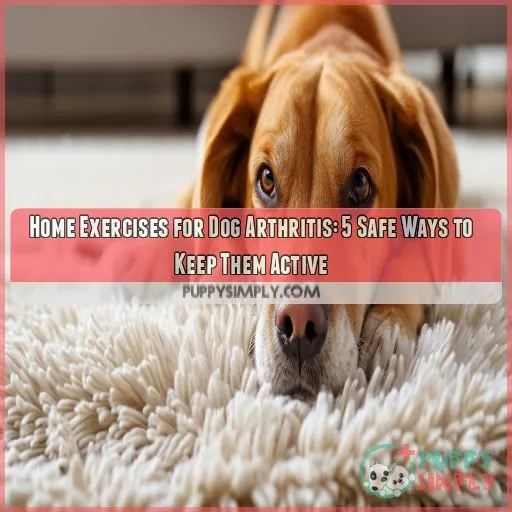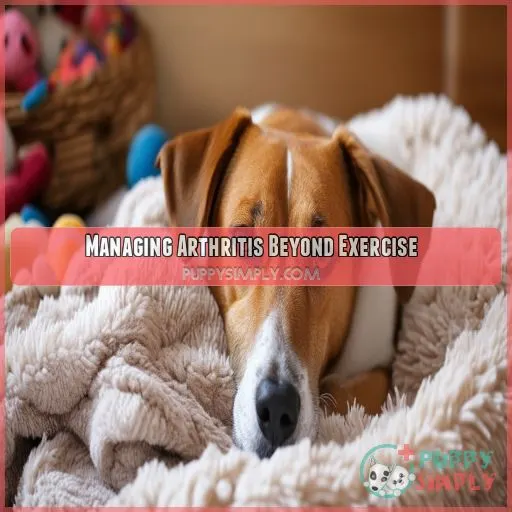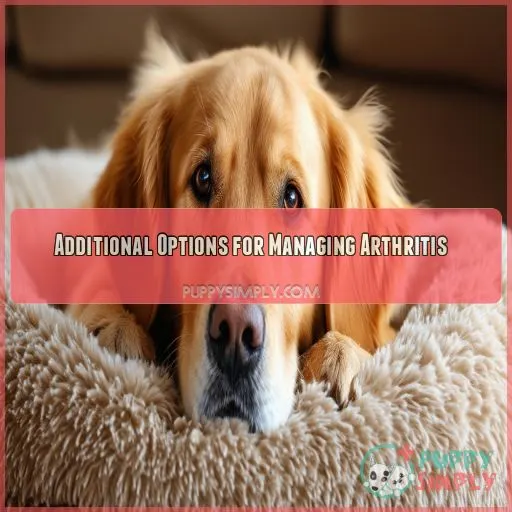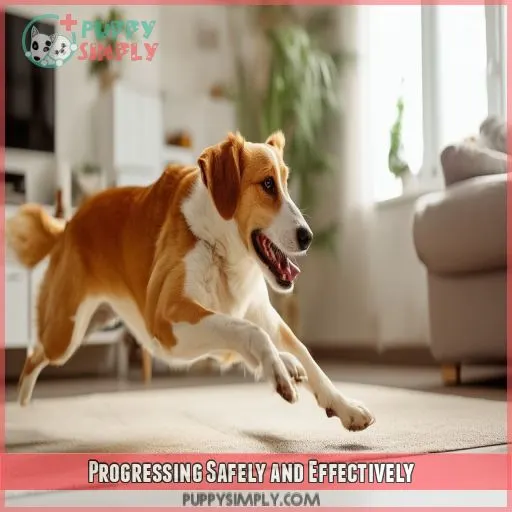This site is supported by our readers. We may earn a commission, at no cost to you, if you purchase through links.

You’re not alone – plenty of dog owners face this issue.
Exercise can be a great way to help your furry friend manage their pain and stay active, but it’s important to do it safely.
In this article, we’ll outline some safe and effective home exercises for dogs with arthritis, so you can help your pup stay comfortable and happy.
Table Of Contents
- Key Takeaways
- Safe Exercises for Arthritic Dogs
- Managing Arthritis Beyond Exercise
- Additional Options for Managing Arthritis
- Building a Foundation for Success
- Starting Slowly and Safely
- Progressing Safely and Effectively
- Frequently Asked Questions (FAQs)
- How to help a dog with arthritis at home exercise?
- Should I exercise my dog with arthritis?
- Can I treat my dogs arthritis at home?
- What aggravates arthritis in dogs?
- What if my dogs arthritis gets worse?
- How can I tell if my dog is in pain?
- Are there supplements to help my dogs arthritis?
- How long will it take to see improvement?
- What are the best low-impact exercises for dogs with arthritis?
- Conclusion
Key Takeaways
- Swimming is a super way to ease joint pain – think doggy paddle!
- Keep walks short and sweet, on flat ground, to improve mobility without the ouchies.
- Stretching is key to keeping your pup agile and limber, like a warm-up before the big game.
- Scent hunts are a fun, slow-paced way to keep their noses busy and brains buzzing.
Safe Exercises for Arthritic Dogs
Arthritis is a challenging condition for our furry friends, causing discomfort and limiting their mobility. As a caring dog owner, you want to keep your pooch active and healthy, but you may wonder which exercises are safe for their achy joints.
Swimming for Pain Relief
Swimming is a great exercise for dogs with arthritis. Buoyancy reduces joint stress, making movement easier and more comfortable. Enroll your dog in a dog-friendly pool or rehab center for safe swimming sessions.
Leisurely Walks for Mobility
Short, leisurely walks are a great way to improve your dog’s mobility without causing joint pain. Keep walks well-spaced and on even terrain.
Treadmill Walking for Controlled Exercise
Treadmill walking is another great option for dogs with arthritis. It offers a controlled environment with a flat, even surface, allowing for a gentle workout that’s easy on the joints. Here are some key considerations:
- Speed: Start slow and gradually increase.
- Incline: Keep it flat initially, then introduce a slight incline for more challenge.
- Duration: Begin with short sessions, extending duration over time.
- Safety: Always supervise your dog.
- Consistency: Aim for regular, consistent sessions.
Balance Board for Strengthening Muscles
5 Safe Ways to Keep Them Active
Try a balance board to strengthen joints and muscles. It improves joint stability and proprioception.
Gentle Stretches for Flexibility
Stretching is key to improving your pup’s flexibility and range of motion, which are really important for their overall health and well-being. Here are some benefits of gentle stretches:
- Alleviate Muscle Tightness: Stretching helps ease muscle tension, making it a great way to start and end your dog’s day.
- Improve Flexibility: Over time, stretching increases your dog’s flexibility, allowing for a wider range of motion.
- Reduce Risk of Injury: By keeping your dog’s muscles loose and limber, you lower the chances of them pulling or straining something during daily activities.
- Promote Joint Health: Stretching increases blood flow to the joints, keeping them lubricated and healthy.
Scent Hunts for Mental Stimulation
Scent hunts are like hide-and-seek for dogs. Hide treats or toys, and let your pup sniff ’em out. It’s a fun, slow-paced mental game for dogs with arthritis.
Managing Arthritis Beyond Exercise
Arthritis in dogs is about more than just exercise. It’s important to pay attention to any signs of pain or lameness and take a proactive approach to managing your pup’s condition. From maintaining a healthy weight to consulting with a vet, there are several ways to help your furry friend stay active and comfortable.
Investigating Signs of Pain or Lameness
Keep a close eye on your furry friend for any signs of pain or lameness. This could be limping, whining, stiffness, or a decrease in their usual zoomies around the park.
- Limping
- Whining
- Stiffness
- Decreased activity
Maintaining a Healthy Weight
Keeping a healthy weight is really important for managing your dog’s arthritis. Those extra pounds can put more stress on their joints, making the condition worse.
Feeding a Balanced Commercial Diet
For good nutrition, a balanced commercial diet is key. You want to make sure your pup’s getting all the nutrients they need to stay healthy and manage their arthritis.
Limiting Treats for Weight Management
Keeping your dog at a healthy weight is key to managing their arthritis. Limit treats to 10% of their daily calories.
Consulting With a Veterinarian
While home exercises are a great way to help your dog manage arthritis, consulting a veterinarian is key. A vet can provide:
- A proper diagnosis
- Treatment plans made just for your dog
- Preventative care advice
- Referrals to specialists, like dog rehabilitation therapists
Additional Options for Managing Arthritis
Beyond home exercises, there are additional options to help your furry friend manage arthritis and stay active. From medication and joint supplements to surgery and physical therapy, let’s explore these avenues to keep your pup’s tail wagging.
Medication for Pain Relief
While exercise is key, medication can provide much-needed pain relief for your pooch. Pain relievers and anti-inflammatory drugs are commonly used to manage arthritis pain and reduce inflammation.
Joint Supplements for Joint Health
Joint supplements like glucosamine and chondroitin can help maintain joint health and reduce arthritis symptoms. Consult your vet for supplement choices and dosage concerns.
Surgery for Damaged Joints
Sometimes, surgery may be the best option for your furry friend. If your dog’s arthritis is severe and causing significant pain or mobility issues, surgery can repair damaged joints and improve their quality of life.
This option may come with a hefty price tag, so be sure to research costs and recovery times. The procedure and post-op care can be intensive, so it’s important to understand the risks and benefits before making a decision.
Physical Therapy for Personalized Exercise
Physical therapy is another valuable tool in your dog arthritis advocacy toolbox. An animal physical therapist can create a customized rehab program to support your dog’s joint health and manage pain. Here’s how:
- Assessment: They’ll assess your dog’s condition, considering their specific needs and limitations.
- Personalized Routine: Based on the assessment, they’ll design a personalized exercise routine that fits your dog’s arthritis.
- Joint Support: The exercises will target joint flexibility and strength, helping to reduce pain and improve your dog’s mobility.
- Pain Management: Physical therapy can include techniques like massage and hydrotherapy to further alleviate pain and improve your dog’s overall quality of life.
Lifestyle Modifications for Easy Movement
Small changes around the house can make a big difference for your furry friend. Try dog ramps, stairs, or special bedding to help them move with ease.
Building a Foundation for Success
Before diving into exercises for your arthritic dog, it’s important to establish a solid foundation for success. This means ensuring your dog has a basic understanding of obedience commands and is motivated by rewards.
Mastering Basic Obedience Commands
Mastering basic obedience commands like "sit," "stay," and "come" is key to successful training. Patience, consistency, and reward-based training will strengthen your bond and their muscles.
Reward-Based Training for Motivation
Treats, praise, and toys can motivate your pup to exercise. Positive reinforcement builds a strong bond and encourages them to keep moving.
Clicker Training for Precise Training
Clicker training is a powerful tool for precise training. It uses a clicker (or a verbal cue) to mark the exact moment your dog displays a desired behavior. This clear signal helps your dog understand what earns rewards, making training more effective and efficient.
Capturing Positions for Natural Behavior
Capturing positions is all about turning your dog’s natural behaviours into exercises. Reward play bows or backward walking with treats, praise, or toys. It’s a fun, effective way to build a strong bond and motivate your pup.
Seeking Professional Help for Guidance
Sometimes, your furry friend needs a little extra help. If they’re struggling with commands or specific exercises, it’s time to call in the pros. A professional dog trainer can offer guidance and support, ensuring your pup masters those tricky moves. It’s like having your own personal cheerleader and coach rolled into one!
Benefits of Seeking Professional Help:
- Expertise: Trainers offer a wealth of knowledge and experience.
- Customized Plans: They tailor exercises to your dog’s unique needs.
- Motivation: Pros know how to keep your pup engaged and excited to learn.
- Support: You’re not alone; they provide guidance and encouragement.
Starting Slowly and Safely
When easing your dog into an exercise routine, it’s really important to start slowly and safely. You don’t want to push your furry friend too hard, too fast. Begin with exercises that are comfortably within their capabilities, and gradually work up from there.
Gradual Progression for Comfort
When starting an exercise routine with your arthritic dog, it’s really important to take it slow and steady. Begin with a level or distance that your dog can comfortably manage without pain. Patience is key.
Establishing a Baseline for Fitness
You need to figure out a starting point for your dog’s fitness level to keep them safe. Check out how much energy they’ve and what they can do to avoid pushing them too hard.
Three tips to figure out a starting point:
- Assess energy levels
- Observe natural behaviours
- Monitor health signs
Prioritizing Form Over Quantity
When it comes to exercising your arthritic dog, it’s important to prioritize form over quantity. This means focusing on quality movements and making sure your dog maintains proper form throughout their exercises.
| Keyword | Explanation | Example |
|---|---|---|
| Form | Refers to the way your dog’s body is positioned during exercise. | Keeping their back straight and level when walking. |
| Quality | Emphasizes the importance of correct and precise movements. | Taking shorter strides to maintain a steady gait. |
| Quantity | Relates to the number of repetitions or duration of exercise. | Doing 5 perfect stretches vs. 10 sloppy ones. |
You want to make sure your dog is doing exercises correctly and comfortably, even if it means doing fewer repetitions or taking shorter walks. This approach helps build a solid foundation for their fitness journey and reduces the risk of injury.
Short Walks for Pain-Free Exercise
Short walks are key to pain-free exercise. Start with a 1-2 minute stroll to make sure your pup’s comfortable. Gradually increase the duration of walks to build their endurance without causing discomfort.
Avoiding Overexertion for Injury Prevention
It’s super important to avoid overexerting your arthritic dog when it comes to exercise to prevent injuries. Start slowly and safely, gradually increasing the intensity of their workouts over time.
Progressing Safely and Effectively
Now that your dog has mastered the basics, it’s time to step it up a notch. You’ll want to increase the challenge gradually, pushing their fitness without overdoing it. This means a careful approach, making small adjustments to keep things interesting and beneficial.
Gradually Increasing Load for Fitness
You’ve got to challenge your dog’s fitness without pushing them too far, too fast.
So, how do you do that?
Gradually increase the load on their body by extending walk durations, and introducing new distances and inclines.
Adapting to Load for Strength and Endurance
Your dog’s body will adapt to the forces placed upon it, leading to increased strength and endurance over time. Here are three ways to adapt to load:
- Increase the load: Gradually increase the weight your dog carries during walks. Start with light weights and slowly add more as their strength improves.
- Change the terrain: Introduce different surfaces and inclines to challenge their balance and stability.
- Add resistance: Use resistance bands or similar tools to create resistance during walks, which will help improve their muscle strength.
Increasing Time for Cardiovascular Fitness
As your pup’s endurance buddy, you can help them build cardiovascular fitness by increasing the time they spend on exercises like walking or stretching. It’s like training for a marathon—slow and steady wins the race.
Increasing Distance for Stamina
You can also increase the distance of walks to build your dog’s stamina. Gradually increase the distance to avoid over-exertion and give their body time to adapt.
Increasing Intensity for Muscle Activation
You can also increase the intensity of exercises to activate your dog’s muscles and build strength. Here’s how to do it safely and effectively:
- Add challenges: Introduce uneven surfaces, faster walking paces, or inclines/declines to walks.
- Use resistance: Try adding resistance bands or light weights to exercises for muscle-strengthening.
- Vary routines: Mix up your dog’s routine with different exercises to keep them engaged and challenged.
- Monitor form: Watch your dog’s form carefully. Stop the exercise if their form deteriorates due to fatigue, as this could lead to injuries.
- Gradual progression: Slowly increase the intensity over time, allowing your dog’s body to adapt and build endurance.
Frequently Asked Questions (FAQs)
How to help a dog with arthritis at home exercise?
First, consult your vet. Then, try low-impact exercises like swimming, leisurely walks, and scent hunts. For extra help, try joint supplements, and always make sure they’ve a healthy weight and diet.
Should I exercise my dog with arthritis?
Yes, exercise is key to managing your dog’s arthritis. The right exercises improve mobility, reduce joint pain, and strengthen muscles. Safe options include swimming, leisurely walks, treadmill walking, and gentle stretches.
Can I treat my dogs arthritis at home?
Yes, you can manage your dog’s arthritis at home with exercises like swimming, leisurely walks, and scent hunts. Consult a vet for advice on treatment, and be sure to warm up and cool down your dog safely.
What aggravates arthritis in dogs?
Lots of things can make your dog’s arthritis worse. Steep terrain, overexertion, and high-impact activities like running are common triggers. Consult your vet about safe exercises and always warm up and cool down your dog.
What if my dogs arthritis gets worse?
If your dog’s arthritis gets worse, speak to your vet. They can advise on pain relief, medication, and weight loss if your dog is overweight. Surgery and new therapies, like stem cell therapy, are also options.
How can I tell if my dog is in pain?
Your dog might be in pain if they’re whining, panting, trembling, or acting unusually. They might also have physical signs like tight muscles, heavy breathing, or swelling. Always ask your vet if you’re unsure.
Are there supplements to help my dogs arthritis?
Supplements like glucosamine, chondroitin, omega-3 fatty acids, and green-lipped mussel can help your pup. Always consult your vet first—they’ll help you decide what’s best for your dog.
How long will it take to see improvement?
It depends on the treatment. Significant improvement is usually seen after 4 weeks of treatment. For weight loss, you should see decreased lameness after 4 weeks.
What are the best low-impact exercises for dogs with arthritis?
You’re after exercises that won’t cause Fido any ouches. Low-impact exercises like swimming, leisurely walks, treadmill walking, and scent hunts are ideal for dogs with arthritis.
Conclusion
Arthritis in dogs is a common issue, and you’re not sure what to do.
These home exercises are a great way to get your furry friend moving safely and comfortably. From swimming to scent hunts, and with the right training techniques, your dog can stay active and happy.
By also managing their weight, diet, and consulting vets, you’ll have them feeling better. This will help your dog stay mobile and healthy.
These home exercises for dog arthritis provide a great starting point for your pup’s journey to better mobility and health.












